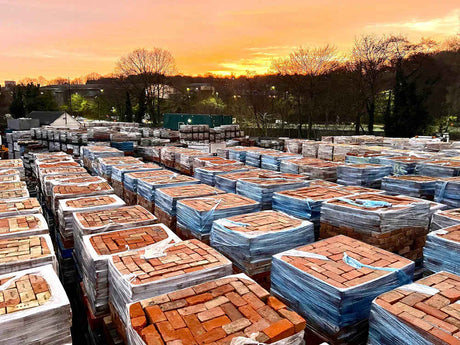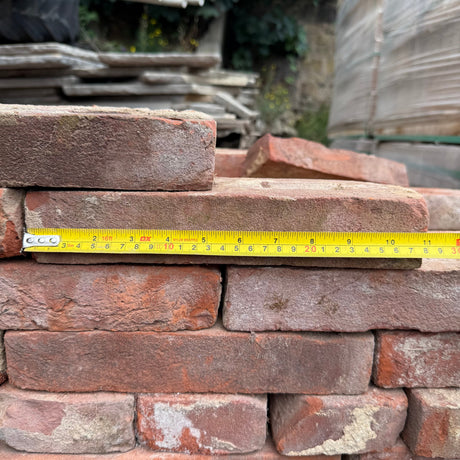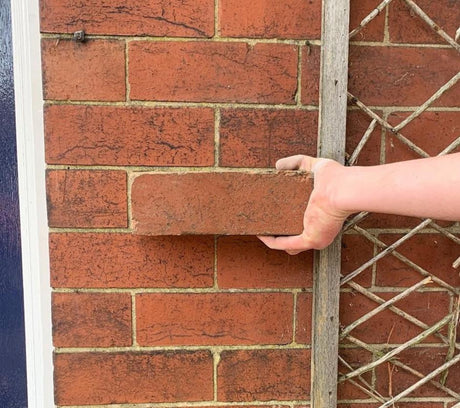Reviving old timber garden methods introduces an exclusive allure to outdoor areas, but purifying them can turn out to be a task. As time goes, railway sleepers in gardens accumulate dirt, grime, moss, and algae, giving them a fatigued and worn-out appearance.
The process of how to purify railway sleepers perplexes numerous homeowners desiring to rejuvenate their bucolic charm.
An unexpected fact is that with a suitable strategy and instruments, bringing back these timbers to their past splendour is not solely achievable but also rather straightforward. This article will steer you through the optimal processes for eradicating undesired grime and safeguarding your railway sleepers against future wear and tear.
Attaining a rejuvenated look for your garden trail or elevated beds has never been more straightforward. Let’s begin!
How Do You Clean Old Railway Sleepers?
To clean old railway sleepers, start by gathering the necessary tools such as a stiff brush, pressure washer, and wood preserver. Use the brush to scrub away loose dirt and debris from the timber, how to clean railway sleepers here.
A pressure washer can then remove deeper grime, algae, and remnants of creosote efficiently without damaging the wood. It’s essential to wear protective gear during this process to avoid contact with potentially harmful substances like creosote.
After washing, applying a wood preserver helps protect the oak garden sleepers from moisture and prevents decay and rot. Choose a preserver that is suitable for use in gardens to ensure safety around plants and wildlife.
Cleaning railway sleepers revives their natural beauty while prolonging their life in your garden.
Next up: How can you further treat these timbers for enhanced longevity?
What Tools Are Needed to Clean Railway Sleepers?
Cleaning railway sleepers effectively requires the right set of tools. It’s essential to have everything you need before you start to ensure a thorough and good clean and how to clean railway sleepers.
-
Stiff brush - Use this to remove loose dirt and debris from the surface. A stiff brush gets into the wood’s grooves, clearing out dust and small particles.
-
Pressure washer - Ideal for blasting away years of grime, algae, and fungus. A jet wash can rejuvenate old timber sleepers quickly.
-
Sandpaper or an electric sander - Perfect for smoothing rough spots and edges. This helps prepare the sleepers for any finish or treatment.
-
Scraper tool - You’ll need this to tackle larger deposits of moss or algae, especially in crevices.
-
Detergent - Essential for breaking down stubborn grime and stains. Use a suitable detergent to enhance the cleaning process.
-
Protective gloves - Always wear these to protect your hands from splinters and any chemicals used in cleaning.
-
Safety goggles - Protect your eyes from flying debris when sanding or pressure washing.
Next, we explore how to remove grime and algae from railway sleepers, ensuring they’re ready for your garden landscaping projects.

How to Remove Grime and Algae from Railway Sleepers
After gathering your tools, the next step involves removing grime and green algae from railway sleepers. This process is essential for restoring the rustic charm and durability of the wood.
-
Start by brushing off loose dirt using a stiff brush. This prepares the sleepers for a deeper clean.
-
Apply a mix of water and mild detergent to the surface. Use a scrubbing brush to work this solution into the wood.
-
For tough grime, consider using a specialised wood cleaner. Ensure it's suited for use on treated or untreated timber.
-
Rinse the sleepers thoroughly with clean water to remove any soap residue. Avoid letting any cleaning solutions dry on the wood.
-
Tackle algae with a solution of water and white vinegar. Spray this mixture directly onto affected areas.
-
Let the vinegar solution sit for at least 15 minutes to break down the algae.
-
Scrub away the loosened algae with a stiff brush, applying more pressure on stubborn patches.
-
If necessary, repeat steps 5 to 7 until all traces of algae are gone.
-
Allow the railway sleepers to dry completely before applying any preservatives or treatments for longevity.
Using these steps helps maintain your garden landscape's aesthetic appeal while ensuring that your reclaimed railway sleepers remain durable over time.
Top Methods for Cleaning Old Timber Sleepers
Once you've cleared the dirt and algae, giving attention to old railway sleeper cleaning is critical. This procedure rejuvenates their condition and readies them for usage in gardening or landscaping tasks.
-
Begin with a straightforward brushing. Utilise a rigid-bristled brush to remove any loose grime, debris, or flaky wood from the sleepers. This action paves the way for additional cleaning.
-
Put to use a blend of warm water and gentle detergent. Lightly wipe the surfaces with this mixture using a sponge or cloth. It aids in eliminating rigid grime without damaging the wood.
-
Rinse thoroughly with pure water. Confirm no soap residues are left since these might attract extra dirt over time.
-
Treat with a wood preservative specifically suited for garden sleepers. Seek products that provide protection against rot, fungal growth, and insect invasion while being suitable for use in gardens.
-
Employ sandpaper on coarse spots. If sleepers are fragmented or display signs of surface harm, gently sand those areas to yield a smooth finish.
-
Contemplate applying a stain or varnish designed for outdoor use on softwood or hardwood railway sleepers, based on your sleepers' material. This action not simply improves their look but also includes an extra layer of protection against weather factors.
-
For dirt deeply embedded or if the timber is significantly discoloured, choose power washing at a low setting to avoid causing harm to the wood fibres.
-
Rectify any cracks in the timber by filling them with an appropriate exterior-grade wood filler to preserve structural reliability and prevent further splitting.
-
If sleepers have been treated with creosote, make sure they are safe to use in your intended project area since materials treated with creosote may touch skin or clothing.
-
Regular inspections and minimal maintenance will prolong their life cycle even after cleaning; treating sleepers regularly with conservation methods keeps them robust and aesthetically pleasing for extended periods.

What Is the Best Way to Clean Garden Sleepers?
Using a jet wash is a very effective method to clean garden sleepers. This removes dirt, grime, and algae swiftly, leaving the wood looking fresh. Ensure the pressure setting is not too high to avoid damaging the timber.
After jet washing, applying wood preservers can greatly enhance the durability of garden sleepers. Choose products designed for outdoor use that offer protection against rotting and insect attack.
Treating garden sleepers with these preservers every few years extends their life and maintains their appearance, ensuring they continue to serve well in creating raised beds, retaining walls or even garden furniture.
Regular maintenance with preservers keeps garden sleepers in prime condition for years.
For long-term care, inspect your sleepers annually for signs of wear and address any issues promptly. This proactive approach prevents decay and maximises utility whether used railway or newly purchased timber serves as part of your outdoor landscape design.
Using a Jet Wash on Garden Sleepers
A jet wash proves to be an effective tool for cleaning garden sleepers, quickly removing dirt, algae, and grime that may have accumulated over time. This technique allows for a thorough clean without the need for harsh chemicals or abrasive methods that could harm the timber.
Both homeowners and professionals favour this approach as it rejuvenates the wood's appearance, making it look almost new. It is crucial to operate the jet wash at an appropriate pressure setting to prevent damage to the wood's surface.
For those intending to apply preservatives to their garden sleepers after cleaning power jetwashing, it's important that the timber is fully dried after the power jetwashing and washing. This procedure guarantees that treatments like creosote or oil-based wood preservatives stick well and deeply penetrate the timber, providing long-term protection against rot and decay.
Supplying advice on upkeep procedures is extremely beneficial in attaining durable results with treated or untreated railway sleepers used in garden projects for both residential and commercial areas.
Can You Use Wood Preservers on Garden Sleepers?
Yes, you can use wood preservers on garden sleepers to protect them from decay and rot. Garden sleepers often face harsh outdoor conditions, including hot weather, warm water, wet soil and changing weather.
Applying a wood preserver to oak, helps of great value in extending the lifespan of these oak timbers. It's essential for wooden features that may come into contact with ground moisture or are exposed to the elements.
Selecting the right type of exterior wood preserver is key. For hardwood sleepers such as oak, products like Tanalith E offer long-lasting protection without altering the natural beauty of the timber.
Softwood sleepers benefit from treatments that penetrate deeply to shield against fungi and insects. Always ensure the product is suitable for garden use, especially if your sleepers will support raised-bed gardening or be near compost areas where food might grow.

How to Treat Garden Sleepers for Longevity
Garden sleepers add a natural touch and structural integrity to landscapes. To ensure they last, proper treatment is essential.
-
Inspect Sleepers Regularly: Check for signs of decay or damage. Early detection can prevent major issues.
-
Apply Wood Preserver: Use quality wood preservers to protect against rot and decay. Products treated with Barrettine are highly recommended due to their effectiveness in prolonging timber life.
-
Seal the Ends: The ends of sleepers tend to absorb most of the moisture, leading to rot. Sealing them can significantly extend their lifespan.
-
Elevate from Direct Soil Contact: Positioning sleepers on a gravel bed or using a plastic membrane underneath prevents direct soil contact, reducing the risk of moisture-related problems.
-
Ensure Good Drainage: Waterlogged conditions are detrimental to timber sleepers. Guaranteeing good drainage around them will help avoid saturation.
-
Use Creosote-Free Treatments for Play Areas: For garden features like benches or play areas, choose treatments free from creosote due to its carcinogenic character.
-
Reapply Surface Treatments Bi-annually: To maintain their appearance and protective layer, reapply paint or wood stain every two years.
-
Avoid High-Pressure Jet Washing: Although tempting, high-pressure washing can strip away protective layers and lead the sleepers vulnerable to weathering and pests.
-
Deal Promptly with Pest Infestations: If pests are detected, treat immediately with appropriate insecticides that are safe for use in gardens to prevent further damage.
-
Use Treated Softwood for Lower Maintenance: Softwoods treated with either creosote (where safety isn't a concern) or pressure treatment options offer durability without constant upkeep.
These steps will greatly aid in extending the life of garden sleepers, ensuring they remain a beautiful part of your landscape for years to come.
Moving on, consider how maintaining these exterior wood and timber structures impacts overall garden aesthetics and usability.

Are Railway Sleepers Safe to Use in Gardens?
Railway sleepers have become a popular choice for garden landscaping, offering a rustic and durable option for borders, steps, and raised beds. Yet safety concerns arise with the use of older, reclaimed sleepers treated with creosote.
This treatment preserves wood but can pose risks due to its chemical composition. Creosote-treated sleepers released into the environment or handled without protection may harm plants and people.
The European Union restricts creosote use in residential areas, underlining these health risks.
Choosing safer alternatives is vital for those planning to use railway sleepers in gardens. New oak sleepers or those undergoing pressure treatment provide a robust solution without the hazardous side effects associated with creosote impregnation.
These materials ensure longevity and resistance against rotting while keeping garden spaces safe for everyone involved. Homeowners and professionals alike must opt for non-creosoted timber whenever possible to maintain both aesthetic appeal and environmental health in their projects.
Understanding Creosote-Treated Sleepers
Creosote-treated sleepers have long been a staple in constructing durable railway ties and garden features, thanks to their ability to resist rotting. This treatment involves impregnating wood with creosote, a preservative that significantly extends the timber's lifespan by protecting it against decay and insect attacks.
Historically, this method has provided an effective solution for ensuring the longevity of wooden structures exposed to the elements.
However, concerns over creosote's safety have emerged, particularly in relation to its use in residential settings. Studies indicate that creosote can pose health risks if it comes into direct contact with skin or is inhaled over prolonged periods.
As a result, many countries have introduced regulations governing the use of creosote-treated wood products, especially within environments where human exposure is likely. Despite these precautions, reclaimed railway sleepers treated with creosote are still used in gardens across the United Kingdom for building raised beds and landscaping features but require careful handling and maintenance.
Safety Measures for Using Reclaimed Railway Sleepers
Understanding the characteristics of creosote-treated sleepers is vital for safe intake of reclaimed railway sleepers into your ventures. Reclaimed sleepers bring a unique rustic appeal and durability to landscapes, but handling them cautiously is crucial.
-
Put on protective gloves and a mask while managing railway sleepers, specifically those treated with creosote. This ensures your skin and lungs stay clear of potential irritants.
-
Refrain from using creosote-treated sleepers in areas where frequent skin contact may occur, like seating or play zones. Creosote can communicate with the skin, resulting in irritation.
-
Set a barrier between garden soil and creosote-laden sleepers if employing them for lofty beds. This will halt any leachate from polluting your soil.
-
Accommodate reclaimed railway sleepers in an area with proper ventilation ahead of the installation to let any remaining chemicals dispel.
-
Review local rules concerning the usage of creosote-treated wood in domestic zones, as some areas enforce restrictions due to ecological considerations.
-
Prefer pressure-treated or natural hardwood sleepers for indoor utilisation or close-contact applications. These serve as more secure alternatives to creosote-treated timber.
-
Regularly examine the installed railway sleepers for indications of wear or chemical seepage, substituting them if required to uphold safety norms.
-
Brief any contractors or designers involved in your project about the type of materials utilised, guaranteeing they adopt the necessary safety precautions.
The responsible use of reclaimed railway sleepers ensures your garden ventures are beautiful as well as secure for all participants.
Alternatives to Creosote-Treated Sleepers
After discussing safety measures for using reclaimed railway sleepers, it's essential to explore alternatives to creosote-treated options. Many people seek safer materials for garden projects.
Pressure treated sleepers offer a robust substitute. These undergo pressure treatment to prevent them from rotting and collapsing, making them suitable for other garden furniture, fences and decking.
Unlike creosote-impregnated lumber, pressure treated wood doesn't pose the same level of health or environmental risks.
Another option is using tropical hardwoods such as oak, which are naturally longer lasting without the need for chemical treatments. These hardwoods provide great value due to their durability and resistance against decay.
They make excellent choices for furniture like coffee tables and can also be used along the length of a garden fence, adding both function and beauty to outdoor spaces without harming the environment or human health.
How to Maintain Timber Sleepers in the Garden
Maintaining timber sleepers in the garden starts with preventing decay and rot. Apply a wood preserver annually to protect them from moisture and pests. Select preservers that are compatible with garden sleepers, ensuring they offer enduring protection against weathering.
For sleepers already in place, check them regularly for signs of wear or damage, addressing issues promptly to lengthen their lifespan.
Consistent maintenance guarantees your timber railway sleepers retain their durability and appeal.
For optimal upkeep, ensure the area around the sleepers is free from debris and vegetation that might retain moisture on the wood. This practice keeps them dry but also deters pests from establishing.
Every few years, it may be beneficial to smooth down any rough patches on the sleepers to prevent splinters and retain their look, applying a fresh layer of preservative after smoothing.
Preventing Decay and Rot in Timber Sleepers
To keep timber sleepers from decaying and rotting, it's crucial to treat them with wood preservers. These chemicals shield the wood from fungi and insects that can cause damage. Before applying any preserver, ensure the sleepers are clean and dry.
This approach helps in making them much more durable. Choosing sleepers treated either with an oil, creosote oil or pressure treatment oil is also a wise move for longevity.
Regular checks for signs of wear and tear play a key role in maintaining their condition over time. Replace damaged ones promptly to avoid further deterioration of surrounding materials.
Keeping sleepers off direct contact with soil by using gravel or sand beds can significantly reduce moisture uptake, which is often a precursor to decay and rot.
Best Wood Preservers for Garden Sleepers
Preventing decay and rot in timber sleepers lays the foundation for their long-term durability. The next critical step is selecting the best wood preservers. These products extend the life of garden sleepers by shielding them from weathering, insects, and fungal attacks.
Opt for preservers containing natural oils or eco-friendly chemicals for a less harmful impact on your garden environment.
Applying a wood preserver that suits both new and old railway sleepers ensures they maintain their structural integrity over time. Search for options labelled as suitable for use with creosote-treated or pressure-treated wood, depending on what you have in your garden.
Regular application following manufacturer’s guidelines can prevent them from rotting and collapsing, securing your investment in these versatile landscaping elements.
Regular Maintenance Tips for Wooden Sleepers
Maintaining wooden sleepers in your garden ensures their longevity and preserves their aesthetic appeal. This involves regular checks and treatments suited to wood exposed to outdoor elements and hot weather.
-
Inspect wood sleepers yearly for signs of decay or insect damage. Catching issues early prevents major repairs.
-
Clean sleepers with a mild detergent and water mixture to remove dirt and prevent algae buildup, which can lead to rot.
-
Apply a wood preserver annually to protect against moisture, which can cause warping and rotting. Choose a preserver that's safe for garden use.
-
Keep the area around sleepers clear of debris and foliage to promote air circulation and reduce moisture retention.
-
Use sandpaper to smooth any rough spots or splinters on the sleeper's surface, enhancing safety and appearance.
-
Repair any cracks or splits with wood filler to prevent further damage from water ingress.
-
If sleepers are used for raised beds, ensure good drainage within the bed to prevent waterlogged conditions that can accelerate decay.
-
Seal railway sleepers with a suitable wood finishing product if they're not already treated, especially if used for seating or as part of play areas.
-
Position sleepers away from constant contact with soil or damp ground by setting them on gravel or a hard-standing base to improve drainage around them.
-
Regularly check for any loosening in fixtures or fittings if sleepers are part of structural garden features like steps or retaining walls, tightening as necessary.
By closely following these maintenance tips, architects, builders, contractors, interior designers, and homeowners can enjoy the beauty and durability of wooden railway sleepers for many years without significant deterioration due to exposure to outdoor conditions.
What Are the Benefits of Using Reclaimed Railway Sleepers?
Reclaimed railway sleepers offer significant environmental benefits. They diminish the requirement for freshly cut timber, aiding in the preservation of natural forests and habitats.
This recycling action also lessens the demand for new materials, minimising the carbon footprint associated with production and transport. Moreover, these sleepers frequently undergo treatment with creosote or pressure processing, leading to a longer lifespan in landscaping projects compared to untreated wood.
Viewing it from a costing angle, the use of reclaimed railway sleepers is remarkably economical. Architectural professionals, builders, contractors, interior designers, and homeowners find them budget-friendly as their price is lower than fresh timber, yet they uphold durability and resilience for construction tasks.
They can be used to construct a variety of features such as garden beds; furniture created from railroad tie pieces can bring unique personality to any environment. These factors render reclaimed sleepers an imaginative and pragmatic option in residential and commercial landscaping designs.
Environmental Benefits of Reclaimed Sleepers
Choosing reclaimed sleepers for landscaping and construction projects brings notable environmental benefits. These old railway sleepers, often treated with creosote or pressure treatments to prevent rotting, find a new use instead of ending up in landfills.
This practice significantly reduces the demand for freshly cut timber, preserving forests along with their biodiversity. Also, by reusing these sturdy materials, carbon emissions associated with manufacturing new wooden products decrease.
Utilising reclaimed sleepers supports sustainable building practices and plays a part in a circular economy. Projects using such materials indirectly reduce deforestation rates, thus maintaining natural habitats for wildlife.
As we shift our attention to cost-effectiveness,.

Cost-Effectiveness of Using Old Railway Sleepers
Moving beyond the environmental advantages, the cost-effectiveness of utilising old railway sleepers in landscaping projects is a noteworthy benefit. These reclaimed materials provide an affordable solution for architects, builders, contractors, interior designers, and homeowners alike.
Choosing used softwood railway sleepers can significantly reduce project expenses compared to buying new lumber or other construction materials. Their durability and sturdiness - qualities imparted by either creosote or pressure treatment - make these softwood railway sleepers a wise investment.
They last for many years with limited maintenance required.
The allure of reclaimed timber encompasses its wide-ranging potential in application. From edging gardens to constructing unique furniture pieces, old railway sleepers provide creative flexibility without straining finances.
Their distinctive character contributes aesthetic value that newer alternatives can't imitate. This unique fusion of affordability, durability, and style presents reclaimed railway sleepers as a preferred option for sustainable yet pocket-friendly landscaping projects.
Creative Uses for Reclaimed Railway Sleepers in Landscaping
Reclaimed railway sleepers serve as a resourceful material for imaginative landscaping projects. Landscape architects as well as garden designers often utilise these sturdy, natural materials to establish striking features in gardens and outdoor spaces.
For instance, railway sleepers can adapt into rustic pathways or edging that outlines flower beds and borders. They bring a welcoming, organic appeal to any landscape design, making them well-liked among professionals desiring aesthetics that merge the old with the new.
Furthermore, these reclaimed items are deployed in constructing strong retaining walls and terracing that combat erosion on sloped land while adding visual fascination. Those who construct often opt for using railway sleepers for such projects due to their durability and long-lasting nature.
They are beneficial in managing intricate landscapes and also have a positive effect on environmental sustainability by repurposing wood treated with preservatives such as creosote impregnated processes, which are meant to prevent decay and disintegration.
This strategy of repurposing fits well with the current trend of eco-friendly solutions in construction and design industries.
Conclusion
Cleaning old railway sleepers refreshes your garden in remarkable ways. You need simple tools to start, like a brush and jet wash. These methods scrub away grime and protect wood effectively.
Have you thought about how these tips can transform your outdoor space? They ensure sleepers last longer, looking good as new. Explore more ways to care for reclaimed timber in gardens.
Let this guide inspire you to make the most of every sleeper in your landscaping projects.








